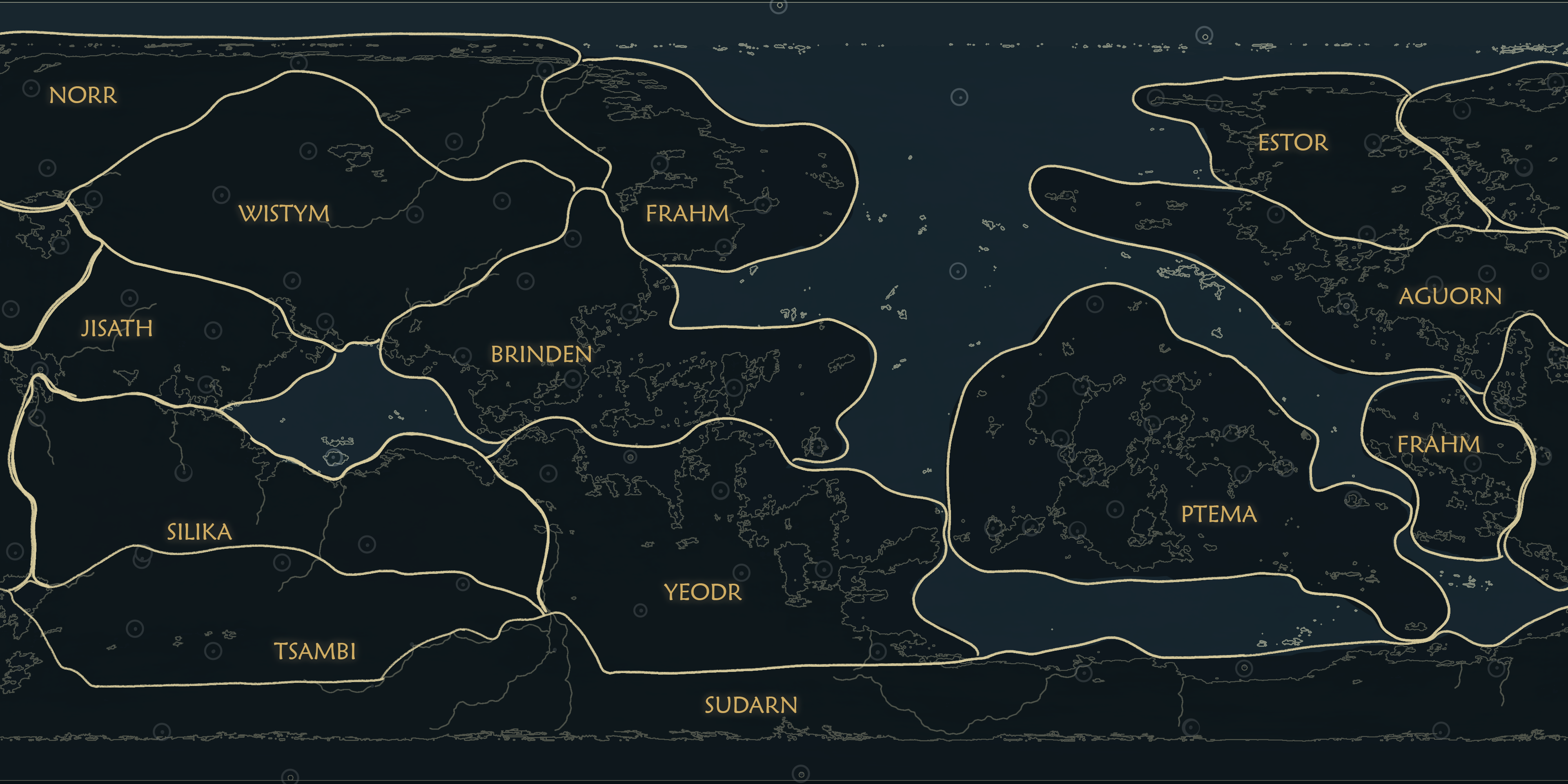Tsambi (Tsam-bee)
The rocky border between the deserts of Silika and tundra of Sudarn. Higher elevations in this region mean most civilization is situated in the mountains, carved in the very rock itself. There are some amazing valleys in this humid region. The region unfortunately suffers from annual tremors and landslides.
THE PEOPLE OF TSAMBI
PERSONALITY
The people of Tsambi are a very quiet and reserved people. Life in the mountains is calm, most people that live here tend to have a steely resolve that has helped them survive the tremors for centuries. The people of Tsambi do not ask of much, preferring to be self sufficient, this has made Tsambi a poor region for trade from outside. Like the neighbourging region of Silika, the Tsambians take care of travellers who have arrived from the harsh deserts. There is always food and water ready for those who arrive parched and famished. The cool mountains offer a respite for the long journey that was taken.PRAYER
Tsambians tend to visit temples daily to offer items to Klodd. This is generally a relic made of plant material in his name. Most of the temples in the region are built into mountainsides and face the valleys. Tsambians will pray at the edge of openings so they can face the beauty of the land the gods created for them. While prayer is happening, a Tsambian will weave plant fibers into intricate chains, the longer the prayer, the longer the chain is. These are brought back to the home and hung on the wall until the next visit.RESPECT
Tsambi is an interesting place, most countries have some sort of hierarchy whereas the mountain region has a communal effort in all matters. Everyone chips in to help the entire community. Most people will tend to others before themselves as others would do the same for them. Tsambians respect all life and the ground-based fauna in the region is not to be hunted for food. It is understandable that the Tsambians often pray to Klodd for his protection and continuation of his slumber so the tremors do not arrive with great vigor. They also thank the deity for their presumption that he sent them The Bridge kiln, that allows travel across the valleys and protection.ELDERS
Each commune in Tsambi has a main person who leads the prayer and deals with messages to other communes in the region. This position holds no power in the running of the commune, but is generally administration and communication done by the oldest person. This person will travel with a small troup of others to visit the communes anually. This is done to see if other communes are in need and they can see if resources can be allocated. When this person passes on, a rite is held. This person is wrapped in plant fibers and cased in mud with flowers placed on top of the form. Left to harden in a room with a fire, once ready, the prayer is held with a ceremonial bell and the body is then thrown over the cliff from the temple to the valley below. This person becomes food for the fauna and thus returns to the earth and become one with Klodd. The valley underneath a temple tends to have bones littered around if the fauna have not also treated themselves to them.ARCHITECTURE
BUILDING MATERIAS
When life is set in the mountains, most building materials are the stone itself. This is retained from carving of houses and temple rooms. The fibers from plant leaves in the valley is used to create furnishings and fixtures for stone and wood. It is a strong fiber when stripped out in complete sections, a grown adult can have trouble trying to snap it in half. The mud from the riverbeds are hardened and soften the hard surfaces of the rocky interiors. A fire in a room will set the mud into a smooth surface.HOUSES
Houses are carved into rockface. Temples tend to be higher in the mountain ranges and houses underneath. The natural rock provides great insulation but also traps in the humidity. Most will have vents to the outside to help regulate the heat. It is common to hear the whistling of the wind inside any structure. Most houses are shades of the grey-red rock and green of the plants that the locals keep inside.TEMPLES
Similar to Houses, temples are also carved into rockface. They favour round shapes in the building and carving of these structures. A round room carries the echoes of songs, a haunting harmony of prayer. Most have a main prayer room with sub rooms for private prayer or tending to the sick and weary. Travellers who pass through the region are welcome to stay at the temple provided they help with the maintenance for the duration of their stay. The temples are adornede with flowers taken from the valleys underneath. The flora adorn the insides of the temples, they grow extremely large in size due to the richness of the soil from water and the rite process.TRADITIONS
TREMOR PREPARATION
The summer months are active in the Tsambi region with tremors in the earth. This can leave the land extremely unstable. As the season is predictable, the Tsambians do their preparation the month before summer. The Tsambians will weave netting out of the leaf fibers. Those gifted will use the metal to fix the netting to the rock of the rooms inside houses and the tombs. In case of being blocked in, food prep is done in advance. The gift of the metal has helped tremendously with the preparation and the cleanup after the tremor season. Most years go now with no injury to locals, any damage to houses or temples can be fixed with new mud from the valley. Every houshokd or temple should have one Ferrus during this season for protection in case of a cave-in.
Type
Region


Comments